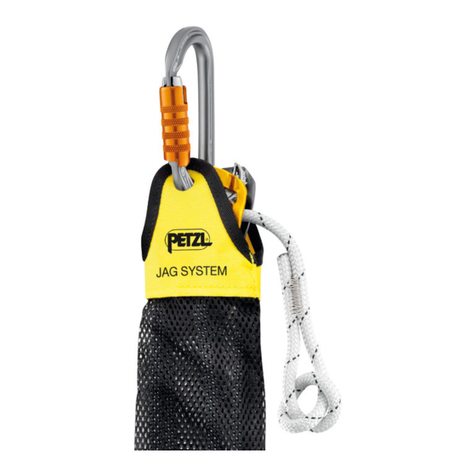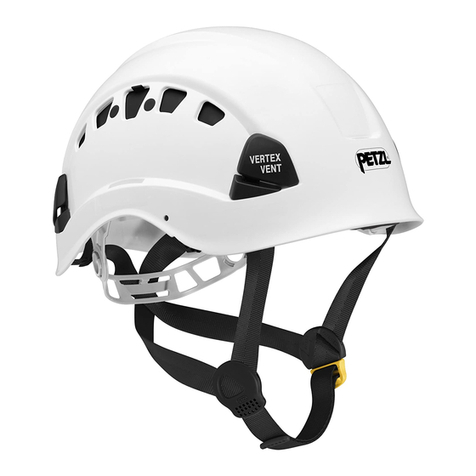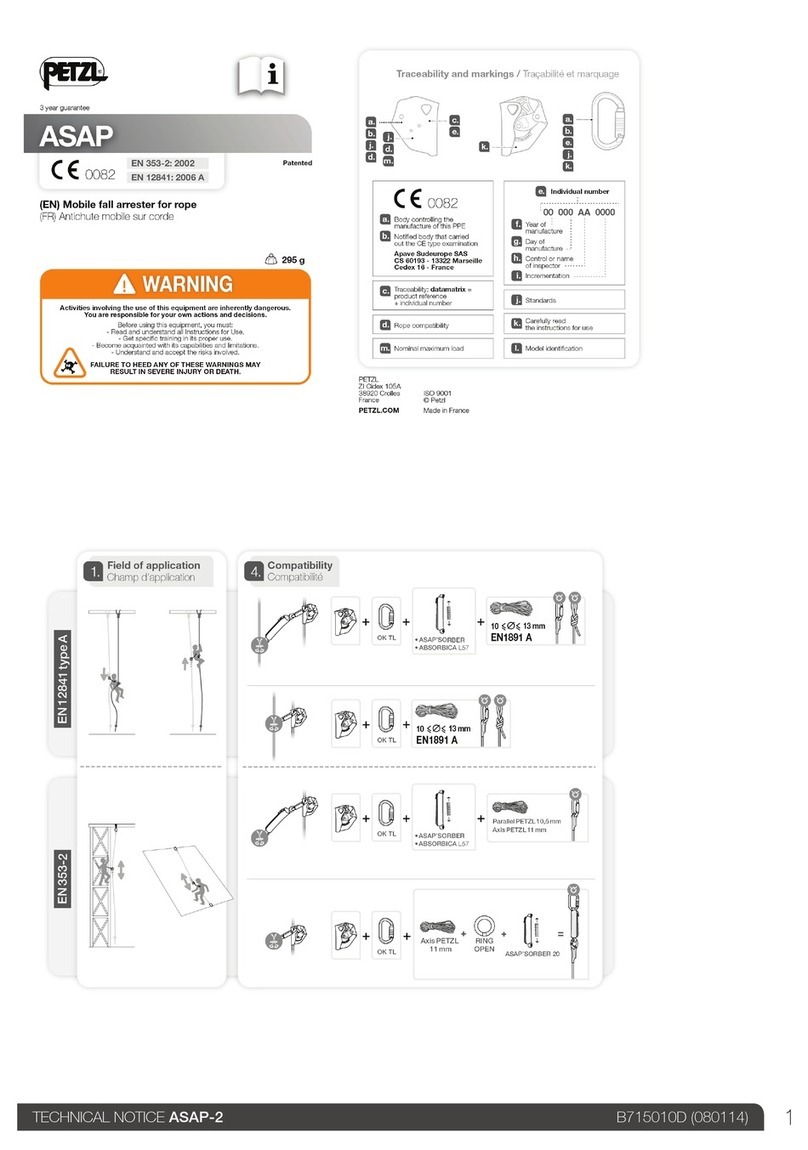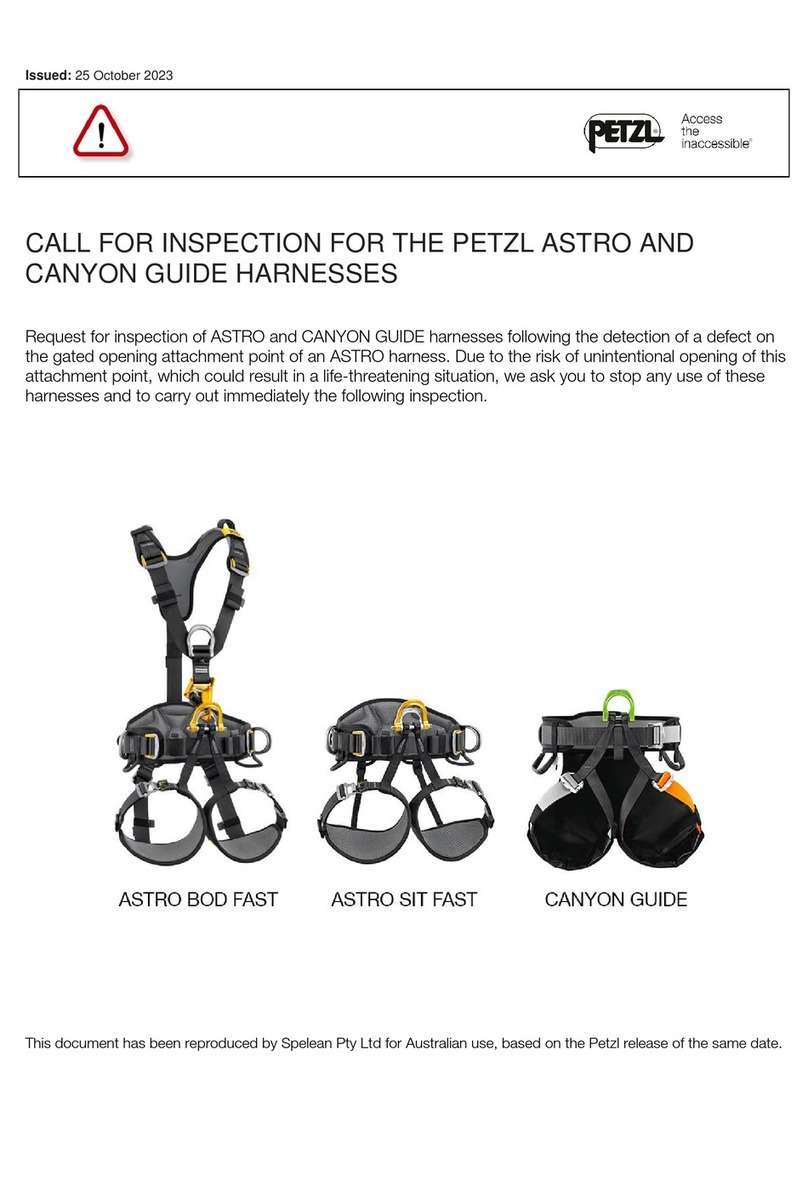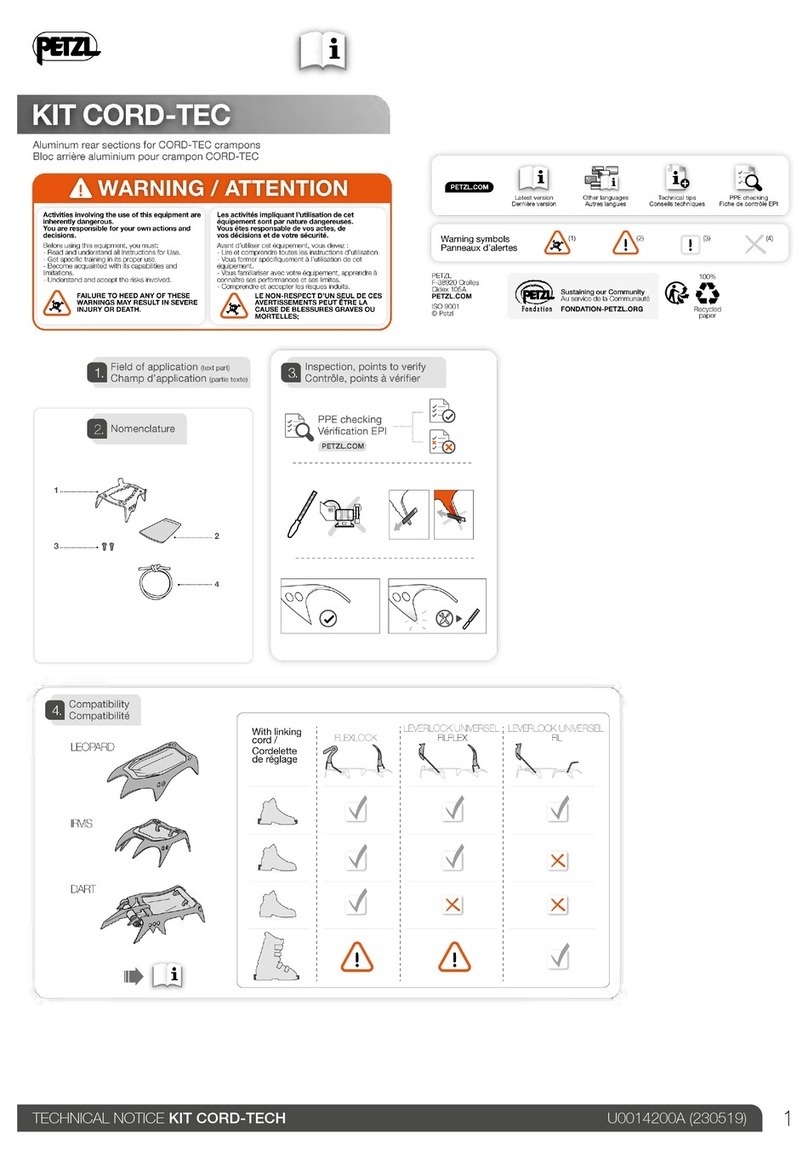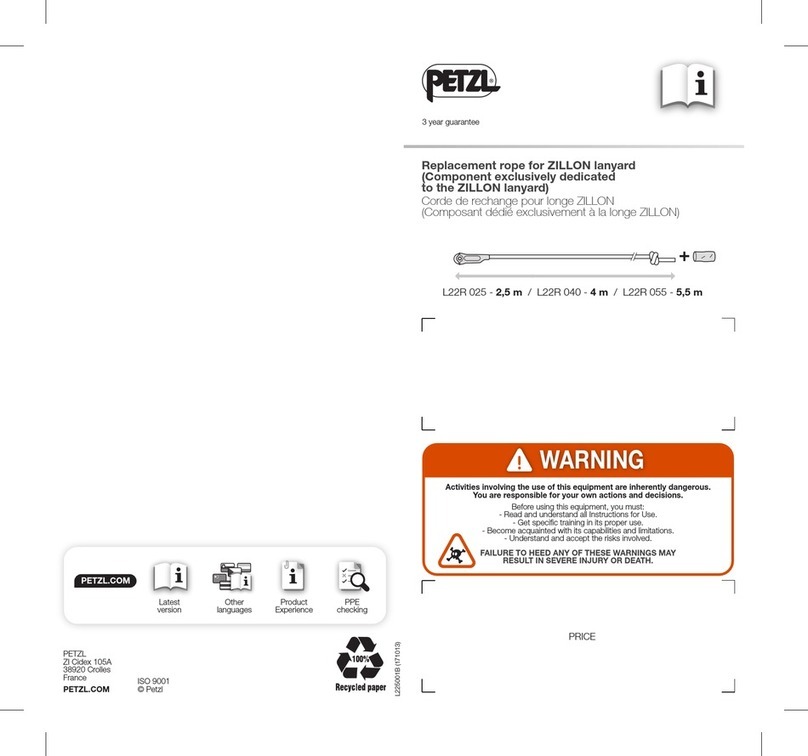
TECHNICAL NOTICE I’D S D0000900A (010616)
22
KR
본 설명서는 장비를 정확하게 사용하는 방법을 설명한다. 특정 기술
및 사용방법만을 소개한다.
사용자의 장비 사용과 관련된 잠재적인 위험에 대한 정보를 전달하나
모든 것을 설명하는 것은 불가능하다. 최신 정보 및 추가 정보는
Petzl.com을 확인한다.
각각의 경고 내용 확인 및 정확한 장비 사용은 사용자에게 책임이
있다. 장비의 오용은 추가적인 위험을 야기할 수 있다. 본 설명서를
이해하는데 어려운 점이나 의문점이 있으면 (주)안나푸르나로
연락한다.
1. 적용 분야
다목적 장비.
이 장비는 단일적으로 사용할 수 없다.
자체 제동 하강기/확보 장비
개인 보호 장비 (PPE).
공칭 하중: 150 kg.
로프로 접근하기 하강하기:
EN 12841 C 형태 로프 조절 장비.
한명 이상의 사람을 후송하기:
EN 341:1997 A 형태 구조 하강 장비.
확보
본 제품은 자체 강도 이상으로 힘을 가해서는 절대 안되며 제작 용도
이외의 다른 목적으로 사용되어서는 안된다.
책임
주의사항
이 장비의 사용과 관련된 활동은 위험성이 내재되어 있다.
자신의 행동이나 결정, 그리고 안전에 대한 책임은 사용자에게
있다.
이 장비를 사용하기 전에, 반드시 알아야 할 사항:
- 사용에 관한 모든 설명서를 읽고 이해하기.
- 장비의 적합한 사용을 위한 구체적인 훈련받기.
- 장비의 사용법과 사용 한도에 대해 숙지하고 친숙해지기.
- 관련된 위험을 이해하고 숙지하기.
이런 경고를 유념하지 않으면 심각한 부상이나 사망을 초래할
수 있다.
이 장비는 전문가와 책임질 수 있는 사람만이 사용할 수 있고,
전문가의 직접적이고 눈으로 볼수 있는 통솔 아래 사용되어야 한다.
행동이나 결정, 그리고 안전에 대한 책임은 사용자에게 있으며
결과물에 대해 예측할 수 있어야 한다. 모든 위험을 책임질 능력이
없거나 그런 위치에 있지 않다면, 그리고 사용설명서를 충분히
이해하지 못했다면 본 장비를 사용하지 않는다.
2. 부분명칭
(1) 움직이는 측면 판, (2) 마찰 판, (3) 힌지, (4) 캠, (5) 안티
에러 캐치, (6) 고정된 측면 판, (7) 핸들, (8) 수평 이동 버튼, (9)
안전 게이트, (10) 구조 키트의 안전 게이트 및 측면판을 잠그기 위한
스크류.
핸들 위치: (a) 이동, (b) 작업 위치, (c) 하강, (d) 패닉 브레이크,
(e) 확보.
전문용어: 제동 손, 로프의 제동쪽.
주요 재질: 알루미늄 합금 (측면판), 스테인리스 스틸(캠, 안티 에러
캐치), 나일론 (핸들).
3. 검사 및 확인사항
사용자의 안전은 장비의 상태와 연관성이 있다.
페츨은 적어도 일년에 한 번 이상 전문가의 세부 검사를 받을 것을
권장한다(사용 국가의 현재 규정과 사용자의사용 환경에 따를 것).
페츨의 웹사이트 Petzl.com에 설명된 절차를 따른다. PPE 장비 서식에
유형, 모델, 제조자 정보, 일련번호 또는 개별 번호, 제조일, 구매일,
최초 사용일, 검사 내용, 문제점, 검사관의 이름 및 서명 등의 PPE
검사 결과를 기록한다.
매번 사용 전에
갈라짐, 변형, 부식 등의 장비 상태를 확인한다.
- 캠의 마모 상태를 확인하고 캠 홈이 마모 표시 부분까지 마모되면
I’D의 사용을 중단할 것(그림 참조).
- 움직이는 측면 판의 변형 혹은 과도한 사용을 확인할 것: 측면 판이
캠 축의 머리부분을 넘어가면, I’D의 사용을 중단 할 것 (그림 참조).
- 잠금 요소 (안전 게이트, 잠금 스크류, 축)와 캠 스프링의 작동,
안전 게이트, 안티 에러 캐치를 확인할 것. 캠의 움직임에 제한이
없는지 점검한다.
- 수평 이동 버튼 스프링을 누른 후 원상태로 돌아왔는지 확인 할 것
(c 위치).
제품 사용 중
제품의 상태와 장치에 연결된 다른 장비와의 연결 부분을 정기적으로
검사하는 것이 매우 중요하다. 장비에 연결된 모든 아이템들이 잘
연계되어 정확한 위치에 놓여 있는지 확인한다.
사망 위험 경고: 장치 및 부품 (캠, 안티 에러 캐치...) 의 작동이
방해받지 않도록 주의를 기울여야 한다. I’D에 이물질이 끼지 않도록
주의한다. 장비에 가해지는 어떤 제한도 제동에 지장을 줄 수 있다.
자유 추락 위험을 줄이기 위해 조프 조절장치와 확보물 사이의 로프는
항상 팽팽한 상태를 유지해야 한다.
4. 호환성
본 제품이 사용시 다른 장비와 호환 되는지 확인한다 (호환이 된다 =
순기능적 상호작용).
I’D S와 함께 사용되는 장비는 사용 국가의 현재 기준에 부합되어야만
한다(예, EN 362 카라비너).
로프
권장하는 직경 및 유형의 합성 섬유 로프만을 사용한다. 그 외의
직경/유형의 로프의 사용은 특히 제동 효율성과 같은 장비의 성능을
변화시킬 수 있다.
경고: 몇몇의 로프는 미끄러울 수 있다: 새 로프, 얇은 로프,
젖어있거나 얼어있는 로프, 등.
5. 작동 원리
로프가 팽팽하게 당겨져 있는 동안(매달있거나 추락 시), I’D는
카라비너에서 회전하며 (1) 캠은 로프를 죄어 제동을 걸 것이다 (2).
로프의 제동쪽을 잡음으로써, 제동 손은 캠이 맞물리도록 한다.
6. 로프 설치하기
I’D S 를 잠금 카라비너와 연결한다.
움직이는 측면판을 연다. 캠을 열기 위해 핸들을 (c)위치 에 둔다.
장비에 있는 그림과 같이 로프를 끼워넣는다. 잠긴 카라비너의
움직이는 측면판 (안전 게이트) 을 닫는다.
경고: 움직이는 측면판은 캠 축과 카라비너에 바르게 맞물려있어야만
한다.
6A. 안전벨트의 장비
6B. 확보물의 장비
카라비너를 사용하여 로프의 제동쪽의 방향을 바꿈으로써 마찰력을
더한다.
경고, 안티 에러 캐치는 뒤쪽에 설치된 로프를 잡을 수는 있지만, 발생
가능한 모든 문제를 해결해주지는 않는다.
7. 성능 검사
매번 사용 전에, 로프가 제대로 설치되어 있는지 그리고 장비가 잘
작동 되는지를 분명히 확인한다. 이 테스트를 진행할 때는 반드시 백업
안전장치를 사용해야 한다.
7A. 안전벨트의 장비
로프의 확보 부분을 당긴다. 로프는 장비에 걸려야만 한다. 로프가
제대로 걸리지 않는다면, 설치상태를 확인한다.
점차 장비에 무게를 싣는다 (로프는 팽팽하게, 핸들은 c위치). 한
손으로 로프의 제동 쪽을 잡고, 로프가 미끄러질 수 있도록 다른
손으로 핸들을 점차 당긴다:
- 하강 가능 = 정상적으로 설치된 로프.
- 하강 불가능 = 로프의 설치 상태 확인 (안티 에러 캐치에 의해
로프가 잠겨있는지).
핸들을 풀면 I’D는 제동을 걸 것이며 로프상에서 잠긴다.
경고: 만일 장비가 계속 작동하지 않으면 (로프 밀림) 폐기한다.
7B. 확보물의 장비
로프의 하중이 실린 쪽을 당긴다. 로프는 장비에 잠겨야만 한다.
로프가 제대로 걸리지 않는다면, 설치상태를 확인한다.
경고: 로프가 제동 카라비너를 통해 방향이 바뀌지 않은 상태로 뒤쪽에
설치되었다면, 안티 에러 캐치가 작동하지 않는다.
경고: 만일 장비가 계속 작동하지 않으면 (로프 밀림) 폐기한다.
8. EN 12841:2006 C형태
EN 12841:2006 I’D S 하강기는 작업용 로프에서 하강하기 위해
사용되는 C 형태 로프 조절기이다. I’D S 하강기는 사용자가 하강
속도를 수동으로 조절할 수 있고 핸들을 풀어 어느 지점에서도 멈출
수 있는 제동 장비다.
EN 12841:2006 C형태 규정의 요건을 충족시키려면, 직경 10 ~ 11.5 mm
사이의 EN 1891 A형태 세미 스태틱 로프를 사용할 것 (속심 + 표피).
(참고: 인증 실험 시 150 kg 물체와 함께 BEAL사의 Antipodes 및 10
mm Ginkgo 로프가 사용되었다.)
8A. 하강하기
1인
안전벨트의 장비 (c위치): 로프를 잡는 제동의 힘에 의해 하강 속도를
조절할 수 있으며, 하강하려면, 핸들을 점차 당긴다. 항상 로프의 제동
쪽을 놓지 않는다.
하강을 중단하려면 핸들을 풀어준다. 패닉 상태: 만약 핸들을 너무
많이 당기면 (d위치) 장비는 제동을 걸 것이며 그런 후에 로프가
잠긴다. 하강을 지속하기 위해서, 우선 핸들을 위쪽으로 올린다 (c
위치).
수평 이동 버튼
비탈진 곳이나 경하중에서 패닉 브레이크는 잘 작동한다. 보다
매끄러운 하강을 위해서, 수평 이동 버튼을 사용한다.
- 수직 하강을 하는 동안에는 수평 이동 버튼을 사용해서는 않된다.
8B. 작업 위치 - 안전한 중단
원하는 위치에서 멈춘 후, 핸즈 프리 작업 위치 모드로 변경하기 위해
하강 반대 방향으로 핸들을 돌려 로프에 장비를 잠근다 (b위치).
작업위치 확보를 위해서 I’D는 제 위치에 놓이도록 한다.
b(작업 위치) 위치에서 핸들이 멈추면, 핸들에 힘을 가하지 않는다.
장비에 로프가 끼워진 채로 핸들이 a(이동) 위치에 있어서는 안된다.
장비의 제동 성능을 방해할 수 있는 장비 손상 위험이 있다.
잠금을 풀기 위해 로프의 제동쪽을 꽉 잡고 하강 위치로 핸들을
이동시킨다.
EN 12841 기준에 관한 정보
경고: I’D S 하강기는 안전 로프로 불리는 2차 로프상에서 A
형태 백업 장치(예: ASAP 추락 방지대)와 반드시 함께 사용해야
한다.
I’D S 하강기는 EN 363 추락 방지 장치 사용에는 적합하지 않다.
EN 362 잠금 카라비너를 사용하여 안전벨트에 바로 하강기를 부착하기.
하강기와 사용하는 어떤 장비도 현 기준에 적합한 것 이어야 한다.
작업 로프 상에서 텐션을 받은 상태라면 안전 로프에 하중이 실리지
않도록 해야 한다.
동적 초과 하중은 안전 로프를 손상시킬 수 있다.
9. EN 341 A 등급 (1997)
구조 후송
최대 하강 높이: 200 m.
일반 작업 하중: 30-150 kg.
확보점으로부터 내리기
확보물의 장비: 로프의 제동쪽은 카라비너를 통해 방향이 바뀌어야
한다. 로프가 미끄러지도록 하기 위해 로프의 제동쪽을 잡고 핸들을 (c
위치)로 올린다. 제동은 로프를 잡는 힘에 의해 조절한다. 자동 잠금
기능을 사용하기 위해 핸들을 풀어준다.
장비에 가볍게 하중이 실렸을 때, 패닉 브래이크가 너무 쉽게
작동한다면 수평 이동 버튼을 사용한다.
EN 341 기준에 관한 정보
- 항상 로프 끝에 매듭을 묶는다.
- 남아 있는 장비는 다른 요소에 영향을 받지 않도록 한다.
- 하강 시, 제어할 수 있어야 한다. 알맞은 속도로 하강한다.
- 경고: 하강하는 동안 장비에 열이 가해져 로프를 손상시킬 수도
있다.
구조 키트
10. 확보보기: 100 kg
경고: 에러 발생 시 (뒤쪽에 설치된 로프), 안티 에러 캐치는 그
지점에서 작동하지 않는다.
확보물의 장비 (e위치): 확보자는 한손으로 로프의 제동쪽을 잡고 다른
손으로는 후등자의 로프를 잡는다. 규칙적으로 로프의 슬랙을 당긴다.
추락을 중단하기 위해 로프의 제동쪽을 단단히 잡는다. 등반자를
내리기 위한 장비 조작 방법은 확보물로부터 내리기의 방법과 유사하다
(제동 카라비너 사용).
11. ANSI 기준 정보
- 최대 하강 높이: 200 m.
- 사용 설명서는 반드시 이 장비의 사용자에게 제공되어야 한다.
- 이 제품과 함께 사용되는 각 장비의 사용 설명서에 반드시 따른다.
- 제조사의 사용 설명서 및 제품 검사 파일에서 권장하는 내용에 따라
제품 검사를 진행한다.
- 구조에 사용된 확보물은 최소 13.8 kN의 스태틱 하중 또는 시스템
상에 가해진 하중을 적어도 5회 이상 지탱할 수 있을 정도로 튼튼해야
한다.
- 구조 시, 추락 제동에 사용된 확보물은 ANSI Z359.1 요건에
부합되어야만 한다.
- 확보물에 한 방향으로만 연결해야 구조 중 시스템의 우발적인 이동을
피할 수 있다. 전체 하중을 적용시키기 전에 연결 상에 텐션 테스트를
수행한다.
- 구조 내용은 ANSI Z359.4 및 Z359.1를 참고한다.
- 구조 계획: 장비 사용 도중에 어려운 상황이 발생할 수 있으므로
반드시 신속하게 이행할 수 있는 구조 계획과 방법을 가지고 있어야
한다.
- 경고: 여러 개의 장비를 함께 사용할 때 한 가지 장비의 안전 성능이
다른 장비의 작동과 연관되어 있다면 위험한 상황을 불러올 수 있다.
- 전기 에너지원, 기기 이동, 거칠거나 날카로운 표면, 화학 물질,
극한의 온도 위험이 있는 환경에서 작업 시 특별히 주의를 기울여야
한다.
- 하강 에너지는 제품의 하강 거리, 사용자의 무게, 중력 가속도와
동일하다.
12. 추가 정보
- 장비 사용 도중에 우연히 부딪치게 될 위기에 대비하여, 반드시
신속하게 이행할 수 있는 구조 계획과 방법을 가지고 있어야 한다.
- 장치의 확보 지점은 사용자 위치보다 위에 설치되어야 하고, 반드시
EN 795 규정의 요건을 충족해야 한다 (최소강도 12 kN).
- 추락 제동 시스템에서, 매번 사용 전 지면에 충돌하거나 추락 시
방해물을 피하기 위해 사용자 아래로 필요한 이격거리를 확인하는
것은 필수이다.
- 위험 및 추락 높이를 제한하기 위해 확보지점이 정확히 위치하고
있는지 확인한다.
- 추락 제동 안전대는 추락 제동 시스템에서 사용자의 신체를 지탱하는
장비로만 사용된다.
- 여러 개의 장비를 함께 사용할 때 한 가지 장비의 안전 성능이 다른
장비의 작동과 연관되어 있다면 위험한 상황을 불러올 수 있다.
- 경고 - 위험: 장비가 거칠거나 날카로운 표면에 마찰되지 않도록
주의한다.
- 사용자는 고소 활동시 신체적 문제가 없어야 한다. 경고: 안전대에서
자력으로 행동할 수 없는 상태로 매달리는 것은 심각한 부상이나
사망을 초래할 수 있다.
- 이 제품과 함께 사용되는 각 장비의 사용 설명서에 반드시 따른다.
- 본 제품의 사용설명서는 장비가 사용되는 국가의 언어로
제공되어야만 한다.
- 제품의 마킹은 알아볼 수 있는 상태여야 한다.
장비 폐기 시점:
경고: 제품의 수명은 제품의 형태, 사용 강도 및 사용 환경에 따라 단
한번의 사용으로도 줄어들 수도 있다 (거친 환경, 고습 환경, 날카로운
모서리, 극한의 기온, 화학 제품 등).
다음과 같은 상태에서는 제품 사용을 중단한다.
- 심한 추락이나 하중을 받은 적이 있는 경우.
- 검사에 통과하지 못한 경우. 장비의 보전상태가 의심되는 경우.
- 장비에 대한 기록을 전혀 모를 경우.
- 적용 규정, 기준, 기술의 변화 또는 다른 장비와 호환되지 않는
경우 등.
이러한 장비가 다시 사용되는 일이 없도록 폐기할 것.
제품 참조:
A. 수명: 무제한 - B. 허용 온도 - C. 사용 주의사항 - D. 세탁 - E.
건조 - F. 보관/운반 - G. 제품 관리 - H. 수리/수선 (페츨 시설
외부에서는 부품 교체를 제외한 수리 금지) - I. 문의사항/연락
3 년간 보증
원자재 또는 제조상의 결함에 대해 3년간의 보증기간을 갖는다. 제외:
일반적인 마모 및 찢김, 산화, 제품 변형 및 개조, 부적절한 보관,
올바르지 않은 유지 관리, 사용상 부주의, 제작 용도 이외의 사용 등.
주의 사항
1. 심각한 부상 또는 사망의 갑작스런 위험이 존재하는 상황. 2. 사고
또는 부상의 잠재적인 위험에 노출. 3. 사용자의 장비의 성능 및 작업
수행에 대한 중요한 정보. 4. 장비 비호환성.
추적 가능성과 제품 부호
a. 본 PPE 장비 제조 인정 기관 - b. CE 유형 시험 수행 기관 - c.
추적 가능성: 데이터 매트릭스 = 일련 번호 - d. 직경 - e. 일련 번호
- f. 제조 년도 - g. 제조월 - h. 배치 번호 - i. 개별 식별번호 - j.
기준 - k. 사용 설명서를 주의깊게 읽는다 - l. 모델 확인



